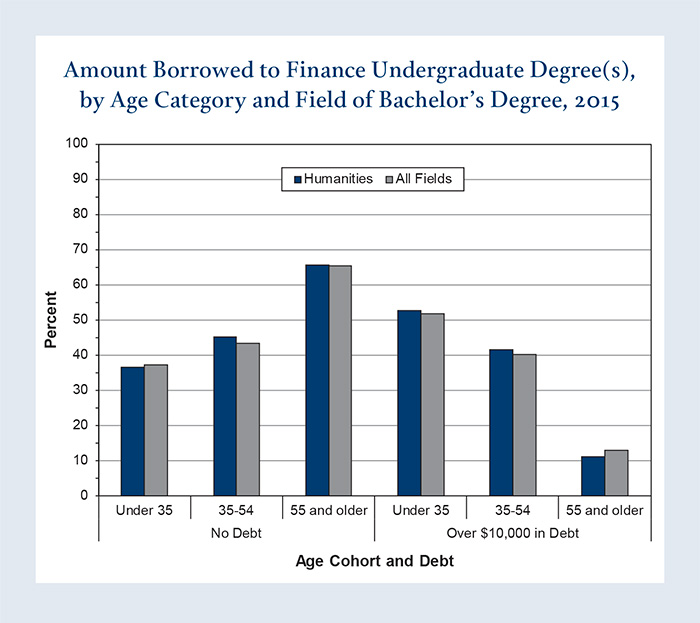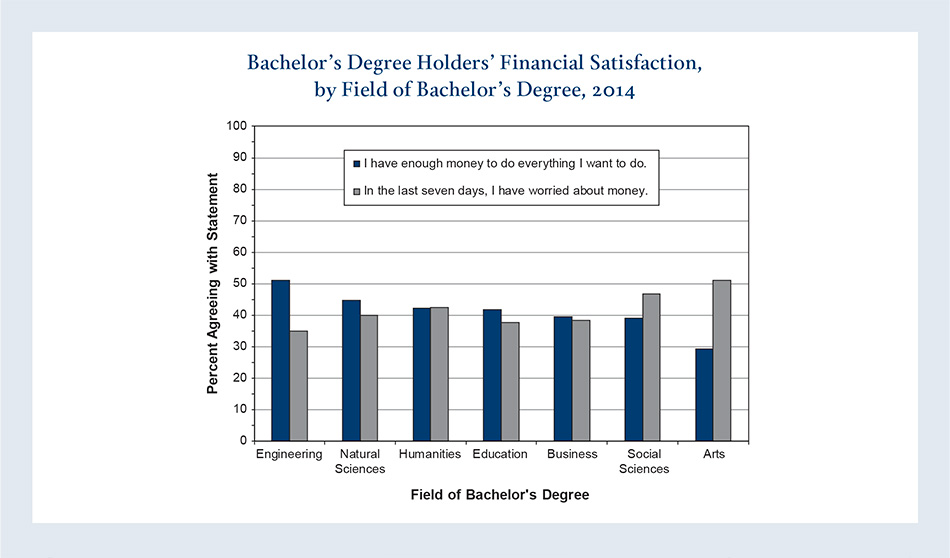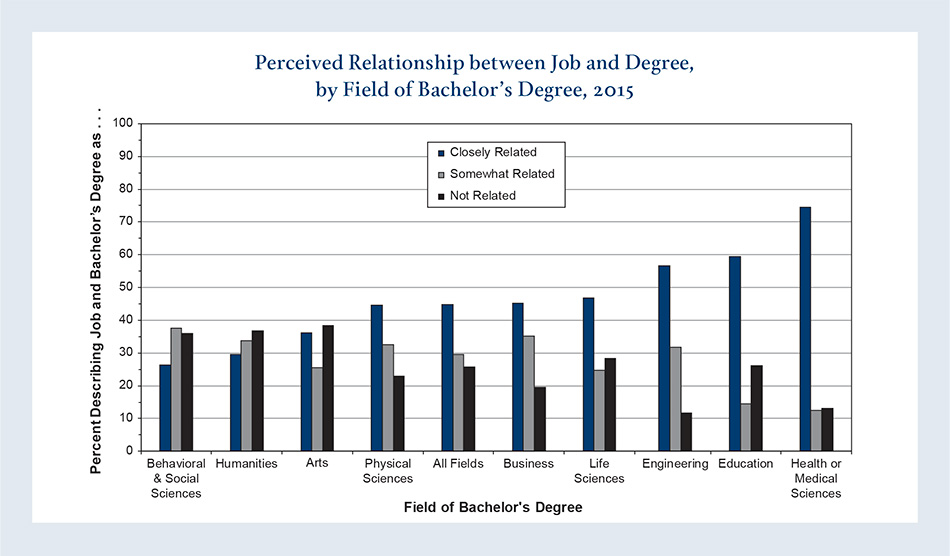While much of the conversation about the value of a college degree tends to focus on graduates’ earnings, a new report from the American Academy of Arts and Sciences’ Humanities Indicators offers a more expansive view. Drawing largely on original research using federal data sets and the Gallup-Purdue Index survey of college alumni, the new report – Graduates in the Workforce & Beyond – finds that college graduates with degrees from fields with below-average earnings (such as education and the humanities) are quite similar to graduates from other fields with respect to their perceived well-being.
Often the value of a college degree is assessed in economic terms. The Humanities Indicators newest report details the median earnings for those with undergraduate degrees in each of the major fields of study, with comparative data on the income differences for women and for those who earn advanced degrees. As the report notes, in 2015 graduates with engineering degrees had the highest median earnings ($82,000), while those with undergraduate degrees in education had the lowest ($44,000). Humanities majors, the principal subject of the report, had median earnings of $52,000.
The report also notes substantial differences among college degree recipients related to factors other than the field of degree. For instance, obtaining an advanced degree makes a clear difference in the earnings of college graduates: the median earnings of those who went on to earn an advanced degree (in any field) were 38 percent higher than those without an advanced degree. Unfortunately, gender also appears to make a substantial difference in graduates’ subsequent earnings. Across all fields, women with college degrees earned an average of 28 percent less than their male counterparts if they had only a bachelor’s degree, and an average of 31 percent less if they held an advanced degree.
The differences in average earnings are often cited in association with rising concerns about growing levels of student debt, with many assuming that majors with lower average earnings suffer more acutely from the problem. A new analysis of debt levels among college graduates as of 2015, however, shows only negligible differences between humanities and non-humanities graduates across all age cohorts. For example, 45 percent of humanities graduates aged 35 to 54 carried no college debt, as compared to 43 percent of graduates from all fields (see Figure 1). Among those aged 55 and older, the share was 65 percent for both humanities and non-humanities graduates. The shares of college graduates with more than $10,000 in debt were similarly close in each age cohort.
 |
| Figure 1 Source and details at http://humanitiesindicators.org |
The report also examines how graduates from the humanities, professional, and scientific fields feel about their jobs and their lives more generally. On these measures, the new data tend to find similarities rather than differences (though it is notable that even though they have the lowest median earnings, college graduates with education degrees generally report the highest levels of satisfaction with their jobs on a wide variety of metrics).
Almost 87 percent of workers with a bachelor’s degree reported they were satisfied with their jobs in 2015, with only a modest difference between the fields. On another measure of job satisfaction, around 80 percent of graduates who had majored in either education or the natural sciences reported “I am deeply interested in the work I do” and that “I have the opportunity to do what I do best every day.” In comparison, engineering and humanities graduates were closer to 70 percent on the same measures.
When asked about their satisfaction with a range of intangible aspects of their jobs, more than 80 percent of college graduates reported they were satisfied with the intellectual challenge of their jobs and their contribution to society, and almost 90 percent reported satisfaction with their level of responsibility and the degree of independence in their jobs. Graduates from education and the health and medical sciences typically had the highest levels of satisfaction with these aspects of their jobs.
Beyond perceptions, the report also highlights similarities between the majors in the kinds of work performed at their jobs. The analysis finds that more than a million graduates with bachelor’s degrees in the humanities were employed as managers in 2015, and almost 60 percent of humanities graduates report managing or supervising employees as part of their job (which was equal to the percentage for all graduates).
The report looks beyond the workforce, to graduates’ feelings about their lives in general. Given the wide disparities in earnings between engineers and graduates from other fields, one might expect a wide gap in their relative sense of financial comfort. Here again, the gap was relatively narrow. As of 2014, only 51 percent of engineering graduates reported that “I have enough money to do everything I want to do.” (see Figure 2) Among humanities and education graduates, the share was 42 percent. Despite substantial differences in median earnings, the share of humanities graduates who had recently worried about money was close to the shares of graduates from the natural sciences, education, and business who had experienced the same anxiety.
 |
| Figure 2 Source and details at http://humanitiesindicators.org |
A new tabulation of the 2014 Gallup-Purdue Index survey of college alumni found only modest differences among majors with respect to the share who believed that they had or soon would realize their “best possible” life. At the time of the survey, over three-quarters of humanities graduates saw themselves as at least 70 percent of the way to this goal, which was similar to the shares of engineering and natural science graduates who believed the same thing. Education majors were the most likely to feel they were close to attaining such a life. In every field, an even larger share of respondents expected to be well on their way to their best life or to have attained that life in five years. Ninety percent of graduates from every other field reported similar levels of optimism about their prospects in the future.
The report notes a substantial difference between scholarly disciplines and professional fields on one metric: less than 30 percent of graduates with bachelor’s degrees in the humanities and social sciences felt that their job was closely related to their degree, while more than a third saw no relationship. Graduates who had majored in business, education, and the health sciences were much more likely to view their degree and work as closely related (see Figure 3).
 |
| Figure 3 Source and details at http://humanitiesindicators.org |
Graduates in the Workforce & Beyond reflects a set of updates to items about undergraduate earnings and employment outcomes recently published on the Humanities Indicators site, which provide more detailed analyses of differences between the fields.
For more information about the Humanities Indicators, including analyses of data for non-humanities fields, please visit www.humanitiesindicators.org or contact the Indicators staff at rtownsend@amacad.org.